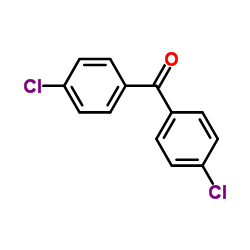4,4'-Dichlorobenzophenone

4,4'-Dichlorobenzophenone structure
|
Common Name | 4,4'-Dichlorobenzophenone | ||
|---|---|---|---|---|
| CAS Number | 90-98-2 | Molecular Weight | 251.11 | |
| Density | 1.3±0.1 g/cm3 | Boiling Point | 353.0±0.0 °C at 760 mmHg | |
| Molecular Formula | C13H8Cl2O | Melting Point | 144-146 °C(lit.) | |
| MSDS | Chinese USA | Flash Point | 156.2±24.3 °C | |
|
A Taiji-principle-designed magnetic porous C-doped graphitic carbon nitride for environment-friendly solid phase extraction of pollutants from water samples.
J. Chromatogr. A. 1412 , 12-21, (2015) A new magnetic porous carbon-doped graphitic carbon nitride nanocomposite and experimental strategies were environment-friendly designed for solid phase extraction of brominated flame retardants from water sample. The easily synthesized and low cost nanocompo... |
|
|
Biodegradation of DDT [1,1,1-trichloro-2,2-bis(4-chlorophenyl)ethane] by the white rot fungus Phanerochaete chrysosporium.
Appl. Environ. Microbiol. 53(9) , 2001-8, (1987) In this work, the application of multivariate curve resolution-alternating least squares (MCR-ALS) is proposed for extracting information from multitechnique fused multivariate data (UV-VIS absorption, fluorescence, and liquid chromatography-mass spectrometry... |
|
|
Organochlorine and heavy metal residues in the water/sediment system of the Southeast Regional Park in Madrid, Spain.
Chemosphere 41(6) , 801-12, (2000) A study into levels of contamination by organochlorine compounds (insecticides and PCBs) and heavy metals (Cd and Pb) in the water/sediment system of the Southeast Regional Park (SERP) in Madrid, Spain, has been carried out. Residue levels of xenobiotics were... |
|
|
Application of QSTRs in the selection of a surrogate toxicity value for a chemical of concern.
Environ. Sci. Technol. 37(22) , 5228-35, (2003) As part of the EPA's mission to protect the environment, chemicals of concern (CoCs) at Superfund or other hazardous waste sites are cleaned up based on their potential toxicity to humans and the surrounding ecosystem. Oftentimes, there is a lack of experimen... |
|
|
Photochemical conversion of a dicofol impurity, alpha-chloro-DDT, to DDE.
Bull. Environ. Contam. Toxicol. 37(6) , 791-6, (1986)
|
|
|
[Comitogenic and immunosuppressant action of p,p-DDT and its derivatives on phytohemagglutinin-stimulated human lymphocytes].
Dokl. Akad. Nauk. SSSR 253(2) , 503-5, (1980)
|
|
|
Potential compounds for monitoring method performance in the determination of selected organochlorine pesticides and polychlorinated biphenyls in human serum.
J. Anal. Toxicol. 14(3) , 143-5, (1990) Four compounds--2,2', 3,4'-tetrachlorobiphenyl, decachlorodiphenylether, 1,1-dichloro-2,2-bis(p-ethylphenyl)ethane, and dichlorobenzophenone--are recommended for monitoring the within-sample behavior of an analytical method that quantifies chlorinated pestici... |
|
|
Dicofol degradation to p,p'-dichlorobenzophenone - a potential antiandrogen.
Toxicology 282(3) , 88-93, (2011) In the present investigation, the degradation of the acaricide dicofol (also known as kelthane) was investigated with special emphasis on generation of p,p'-dichlorobenzophenone (DCBP) under alkaline conditions as well as induced by UV-light. Dicofol was also... |
|
|
Degradation and mineralization of DDT by the ectomycorrhizal fungi, Xerocomus chrysenteron.
Chemosphere 92(7) , 760-4, (2013) One strain of ectomycorrhizal fungi, Xerocomus chrysenteron, had been investigated for its ability to degrade 1,1,1-trichloro-2,2-bis(4-chlorophe-nyl) ethane (DDT) by measuring unlabeled DDT and identifying its metabolites, and determining the mineralization ... |